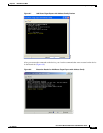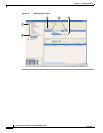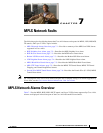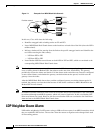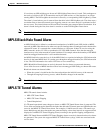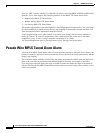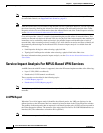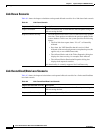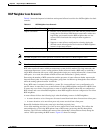
7-5
Cisco Active Network Abstraction 3.6.6 MPLS User Guide
OL-19192-01
Chapter 7 MPLS Network Faults
MPLS Black Hole Found Alarm
If a session to an LDP neighbor goes down, an LDP Neighbor Down alarm is issued. This can happen as
the result of a failure in the TCP connection used by the LDP session, or if the interface is no longer
running MPLS. The LDP neighbor down alarm is cleared by a corresponding LDP Neighbor Up alarm.
The alarm is issued when a peer is removed from the table in the LDP Neighbors tab. The alarm runs a
correlation flow to detect the network core triggering event A root cause analysis is performed to find
the root cause. The alarm initiates an IP-based flow toward the peer transport address destination. If an
alarm is found during the flow, that alarm is correlate to to the LDP Neighbor Down alarm.
Note The LDP Neighbor Down alarm can correlate to the MPLS Interface Removed alarm.
MPLS Black Hole Found Alarm
an MPLS black hole is defined as an abnormal termination of an MPLS path (LSP) inside an MPLS
network. An MPLS black hole exists when on a specific interface there are untagged entries destined for
a known PE router. It is assumed that a router functions as a PE router if there are services using the
MPLS network, such as L3 VPNs or pseudowire (L2 VPN) MPLS tunnels. Note that the untagged
interfaces may exist in the network in normal situations. For example, where the boundary of the MPLS
cloud has untagged interfaces this is still considered normal.
An MPLS black hole cause the loss of all the MPLS labels on a packet including the VPN information
that lies in the inner MPLS label. If a packet goes through an untagged interface, the VPN information
is lost. The VPN information loss causes VPN sites to lose connectivity.
MPLS Black Hole Found alarms are actively detected. Service alarms are generated whenever
Cisco ANA discovers an MPLS interface with at least one untagged LSP leading to a known PE router.
Black hole alarms are detected either:
• When the system is loaded for the first time and performs the initial discovery of the network.
• Through the ongoing discovery process, which identifies changes in the network.
Note The MPLS black hole discovery is supported only when the PEs are managed by Cisco ANA.
MPLS TE Tunnel Alarms
MPLS TE tunnel alarms include:
• MPLS TE Tunnel Down
• MPLS TE Tunnel Flapping
• Tunnel Reoptimized
If a TE tunnel operational status changes to down, an MPLS TE Tunnel Down alarm is generated. The
Cisco ANA correlation engine identifies the faults that affect the TE tunnel status and identifies the root
cause for the MPLS TE Tunnel Down alarm. For example, a Link Down will cause a TE tunnel to go
down. Multiple up and down alarms that are generated during a short time interval are suppressed and
displayed as an MPLS TE Tunnel Flapping alarm (according to the specific flapping configuration).
MPLS TE Tunnel Down and MPLS TE Tunnel Flapping alarms are actively detected and service alarms
are generated. The system also supports MPLS TE Tunnel Down syslogs, which are correlated to the
service alarm.



